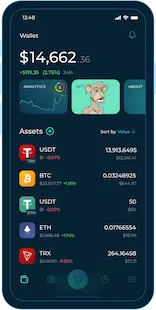Guide to Smarter Portfolio Management
Jan 25, 2023Buying crypto seems easy to everyone. Although it is not easy to decide which cryptocurrencies to buy and how to manage them afterward. In this beginner-friendly guide, we'll go through best practices for managing your crypto holdings successfully.
Read on to learn the basics of portfolio management so you don't have to learn it the hard way — through mistakes and painful experiences.
What is a Cryptocurrency Portfolio?
A crypto portfolio is a set of all the digital assets you purchased and planning to hold. Creating a portfolio implies choosing and managing a group of coins and tokens to hit your financial goals. Considering and acknowledging all the risks is of great significance when selecting currencies to invest in.
How to Create a Crypto Portfolio?
Creating a portfolio is no other than deciding which crypto assets are worth investing in and then purchasing those. You can get crypto from exchanges, peer-to-peer trading services, or directly from your wallet, as many of them offer such an option.
Before diving into the oceans of crypto investment, it's a good idea to lay out a solid investment plan and estimate how much you're ready to invest, how risky you want to go, and what your investment goal is.
Creating a Balanced Portfolio?
Taking precautions against extreme volatility is of ultimate importance in the asset selection process. The Crypto market is known to be highly volatile and equally profitable for the same reason.
While we list the main principles to follow, we assume a long-term investment attitude, since day trading and taking profits from the changing market is a different story.
| Image Source: Hongkiat |
Points to Consider
- Allocatie Rationally
Investing a significant chunk of your net worth is decidedly risk-inducing and stressful. Therefore, make sure to realistically approach the risks and portion out the funds accordingly. - Consider investing in more than one single currency
Just like there is no good in putting all your eggs in one basket, investing in one asset only is fraught with major risks of losing money. Do not underexpose yourself to the crypto market. Overexposing also comes tricky. Find your fine line and stick to it. - Diversify
One more tool for reducing the riskiness of the portfolio is composing it with different types of assets. Combining risky assets with low-risk digital currencies helps to make it through volatility without considerable downsides. If one asset decreases in value, another may surge up and counterbalance the loss. Assets with bigger market capitalization like Bitcoin, Ethereum, BNB, and XRP fall under relatively less risky cryptos.
| Image Source: CoinDCX |
- Stock up some Stablecoins
Another point, adding up to the previous, is to allocate a portion of your holdings to stablecoins (market hedgers) like USDT, USDC, or BUSD. It may facilitate your future purchases as you can easily exchange a stablecoin for an asset you decide to buy when you see a good opportunity to do so. It doesn't mean, however, that stablecoins can't crush - the recent TerraUSD collapse proves the opposite. Yet, top stablecoins are properly backed and will highly likely become your most stable acquisition. - Keep track of your funds
Follow the market tendencies and news from the team behind the project to react to bad or good news and rebalance your portfolio in time. - Prioritize Asset's Security
Wise management of cryptocurrencies turns into a big nothing if we forget about protecting them from fraudulent activities. Find some tips on how to properly care about your funds' safety from our dedicated blog post.
Industry Expert Tips
Practicing crypto traders do have experiences to share. Let's see what they add to our list. CryptoRus warns against panic selling and preaches controlling emotions and FOMO influencing your investment behavior. BitBoy Crypto encourages not to be afraid to say goodbye to some cryptocurrencies without hesitation if you feel things start heating up. Specifically for the bear market we're currently in, Brian Jung suggests Dollar Cost Averaging strategy to build your portfolio consistently over time. He also believes in Bitcoin's upside potential and notes that the bear market is a good opportunity to start accumulating assets with a rebound capacity.
Digital Asset Management Tools
Now that we learned how to compose a portfolio, let's address portfolio management. There are some crypto portfolio trackers in the market made specifically for that purpose like eToro, Pionex, and Shrimpy. However, it's much more convenient to track the assets right from your wallet.
| Image Source: Arctic Wallet App |
Take Arctic Wallet as an example. As you open the wallet and click the “Portfolio” tab, you'll see a dashboard with all the necessary information about your current holdings. Arctic has an in-built chart updated every 60 seconds, it shows the overall cost of all possessed currencies together and separately. It also indicates profits, losses, and 24-hour statistics. Right from the wallet, you can buy and sell assets without wasting a moment. Other than that, it has an in-built exchange to easily convert crypto without leaving your wallet. Arctic, being a non-custodial software wallet, ensures the safety of use and gives you full ownership over your funds.
Closing thoughts
There seems to be no universal recipe for a perfect portfolio. It is the part of your journey to develop a personal strategy fitting your needs. Avoid preconceived narratives and do your own research (DYOR) prior to investing in any token. Investigate core values behind each currency, and personas behind every project.


